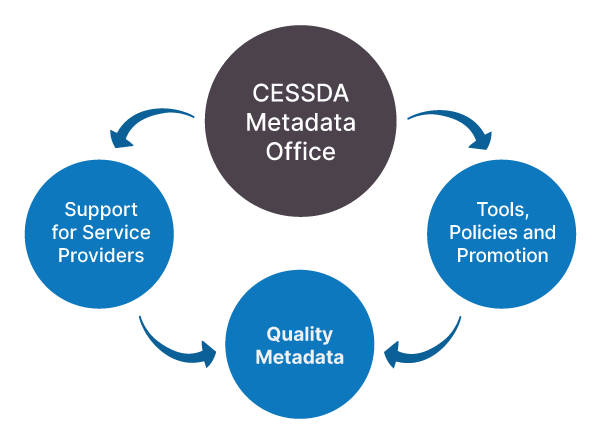
The CESSDA Metadata Office (MDO) is the principal contact for metadata topics, defines strategic metadata requirements and developments, and provides instruments and documents to ensure and enhance quality metadata.
Contact
Get in touch with the CESSDA Metadata Office by email: metadata-office@cessda.eu
Our mission:
- To oversee strategic developments for all metadata-related issues within CESSDA and the implementation of CESSDA products
- To promote the importance of quality metadata for the social sciences community and users of the CESSDA Data Catalogue (CDC)
- To maintain and manage CESSDA’s metadata-related material
- To be the principal point of contact for metadata issues within CESSDA
- To monitor metadata developments in other relevant consortia, institutions, initiatives, and projects to ensure that CESSDA products meet metadata requirements and stay internationally interoperable
- To support and advise CESSDA developments to establish CESSDA as a pioneer in quality metadata
- To define strategic metadata requirements for CESSDA to help plan as well as implement tools and services
Publications
You can find publications and information on the CESSDA Metadata Model (CMM), the CMM User Guide, the CESSDA Metadata Validator (CMV), and CESSDA DDI Profiles below.
MDO maintains CESSDA's official metadata schema, the CMM (https://doi.org/10.5281/zenodo.4672413). The CMM defines a global set of metadata elements supported by CESSDA.
The CMM is built from the perspective of quantitative social science data. Thus, it aims to assist CESSDA Service Providers (SPs) in making their quantitative data more discoverable and understandable to users. The CMM is based on the DDI Lifecycle metadata standard (version 3.2) (https://ddialliance.org/) because it is currently the most comprehensive standard for the social sciences and promotes interoperability. The CMM reduces the complexity of the whole DDI specification.
The first version of the CMM was produced within the CESSDA Metadata Management project. It contains elements relevant for CESSDA, the CESSDA SPs, and CESSDA products. Since then, it has been regularly updated. The first versions of the CMM and its user guide were published (in May/June 2019) via Zenodo. The latest version of the CMM was published (in May 2021) via Zenodo. The CMM can be downloaded and cited using this DOI: 10.5281/zenodo.4672413. The CMM User Guide’s DOI is: 10.5281/zenodo.4672247.
The CMM User Guide (https://doi.org/10.5281/zenodo.4672247) accompanies the CESSDA Metadata Model (CMM). This document includes guidelines for the usage of and best practices for the CMM (https://doi.org/10.5281/zenodo.4672413) The guidelines address all relevant aspects of the elements in the CMM and serve to provide recommendations and guidance for usage.
The primary goal of the CESSDA Metadata Validator (CMV) is to improve metadata quality.
The CMV is an online and command-line-based set of tools. It enables the validation of DDI documents against a given DDI Profile. The CMV checks if a DDI file is valid according to the rules captured in a DDI Profile. Validating metadata documents against the CESSDA Data Catalogue (CDC) DDI Profiles can be done by providing individual metadata records via URL or using the direct upload option. The documentation is linked from the top navigation and a feedback button can be found in the bottom right corner. An API is available as well. If the metadata document (DDI XML file) breaks the rules, the CMV will display a list of validation errors specifying which rules have been broken.
The CMV is designed to validate any DDI XML file against any DDI Profile. Therefore, it can be widely adopted in the future for many use cases.
MDO has produced CESSDA DDI Profiles (DOI:10.5281/zenodo.4580376]) for the metadata schemas of the CESSDA Data Catalogue (CDC). MDO is currently working on further DDI Profiles for the CDC and the CESSDA Euro Question Bank (EQB), based on different DDI specifications. DDI Profiles (https://ddialliance.org/resources/ddi-profiles) are formal, machine-actionable XML (Extensible Markup Language) documents that specify additional constraints on the content of a DDI XML document.
DDI Profiles help to specify DDI XML documents and thus help transfer and achieve the interoperability of DDI instances. DDI Profiles contain a human-readable subset of valid DDI objects used by CESSDA and allow sets of declarations to be made, identifying specific fields in the DDI, e.g., “Used” or “Not Used” and the occurrences of certain elements. The DDI Profiles furthermore support machine-actionable validation by the CESSDA Metadata Validator (CMV).
The first versions of DDI Profiles for CDC, based on the DDI Codebook versions DDI 2.5 and DDI 1.2.2, were published on Zenodo in September 2020. They have already been updated, based on the feedback received from the users of the profiles. Those profiles can be found via the DOI: 10.5281/zenodo.4050123. The published DDI Profiles are intended to be used in the context of validating DDI2.5 and DDI1.2.2 documents of the CDC (meta-)data providers.
UML Model of CMM
The MDO is also working on a UML class model based on the CESSDA Metadata Model (CMM). Besides the CMM XML-centric approach, which is a set of operational rules, a UML class diagram was created to represent the CMM.
This aligns with DDI Alliance’s best practice. Firstly, a platform-independent UML model is designed, and then this can be bound to multiple “serializations”: XML, RDF, or Java classes, or any kind of schema language in principle.
While the UML represents an approach to modeling the CMM, by contrast, DDI Profiles are a mechanism for validating and improving the quality of DDI metadata in specific use cases. The most obvious use case is the CESSDA Data Catalogue, but there are others, such as EQB.